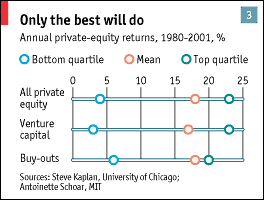Harvard Business School is having a private equity conference for students this upcoming weekend and, regrettably, is featuring Howard Andersen and his ridiculous sour grapes about the VC business. Because of this, I feel obliged to blog on this topic.
Simply put, Howard Andersen’s article is bunk.
The venture capital business is hardly for the faint of heart and, unlike the brief period in the mid- to late-90s, is admittedly not an easy business where even the dumb and lucky can make tons of money. That said, there is still plenty of money to be made and breakthrough innovations to support.
Howard’s comment that the “technology supply is bloated” is absurd. This is an extraordinarily short-sighted view. In the next decade, many predict that someone will fund a company that will cure cancer, if it doesn’t exist today. With the modernization of China and India, we have 2 billion additional consumers entering into the wired world. The venture-backed company, Google, is transforming the trillion dollar consumer marketing industry and print world. The global proliferation of mobile phones has generated a whole new platform of innovation beyond the PC. Anyone in the midst of a healthy flow of deals across technology and biotech will tell you that the pace of innovation continues to quicken, not grind to a halt.
And the description of poor average returns in the business is a simplistic analysis that misses the “dispersion effect” in venture capital returns. VC fund returns are one of the most widely varied by fund manager of any asset class. The top quartile VCs account for the majority of the returns. Even during a period of 0% average returns, top quartile VCs make their investors lots of money. The chart below from The Economist is the best I’ve seen on this topic. Howard is right that if you’re a middling-performing VC, you will not serve your investors well. But the top quartile returns are far better than the S&P and well-deserving of the risk and liquidity premium. This was a big driver behind the recently reported fantastic growth of the Stanford Endowment, who gained 23% last year thanks to its participation in top-tier Silicon Valley funds.

My advice for business school students thinking about the VC business would be similar to what my finance professor, Andre Perold, gave me when I was graduating business school. Andre (who sits on the board of Vanguard and teaches capital markets at HBS) taught me that in every market, there are two types of animals: wolves and sheep. The wolves are faster, smarter and have all the innate weapons to take advantage of the sheep, buying low and selling high. If you find yourself in market where you don’t know if you’re a wolf or not, then by definition you are a sheep and are about to see a nasty finish. The trick for students who want to become VCs is to recognize that although they are initially sheep, if they hang out with a few wolves, learn from them over a number of years, they can grow into becoming wolves themselves. If they don’t, then they will leave the business frustrated and disgruntled rather than stuffed to the gills with its spoils.
